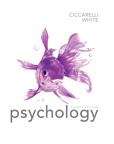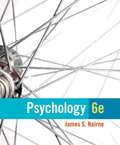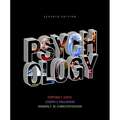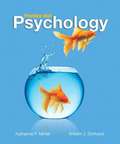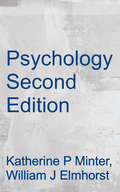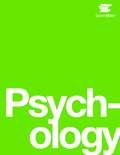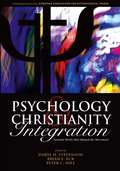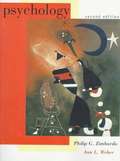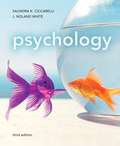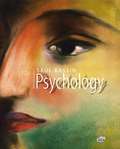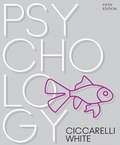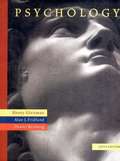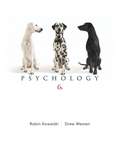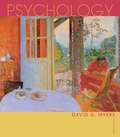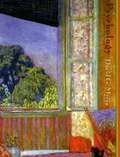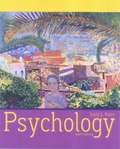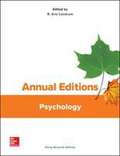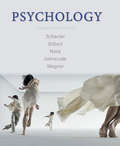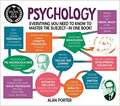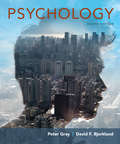- Table View
- List View
Psychology
by Saundra Ciccarelli J. WhiteWith its engaging writing style and comprehensive coverage of key research, Psychology, 4/e, awakens students’ curiosity and energizes their desire to learn more. This title draws learners into an interactive experience of psychology. The authors establish clear learning objectives tied to the most recent APA-recommended undergraduate learning guidelines.
Psychology
by James NairneStraightforward and written in a friendly style, James S. Nairne's PSYCHOLOGY, Sixth Edition, uses a proven problem-solving approach to help you discover how to apply psychology to your everyday life. Dr. Nairne introduces topics by focusing on the "why" behind psychological processes before introducing what they are and how they work. You'll learn that our brains are filled with psychological "tools" that control everything from emotion to memory, and that each helps us adapt and solve important everyday problems. Nairne describes these tools, shows you how they're used, and focuses on specific situations in which they are applied. Emphasizing critical thinking and active learning, PSYCHOLOGY, Sixth Edition, provides current, comprehensive, and practical coverage that you can immediately put to good use.
Psychology
by Stephen F. Davis Joseph J. Palladino Kimberly M. ChristophersonAccessible, Active, and Applied with a focus on different learning styles - Designed to make the Introductory Psychology course an engaging, relevant, and interactive experience, the authors of the new seventh edition of Psychology offer multiple decades of combined teaching experience to create an accessible textbook that encourages applied and active learning. Through this book's accessible, active, and applied approach, users determine whether their learning style strengths are verbal/linguistic, logical/mathematical, visual/spatial, or interpersonal. By encouraging them to study according to their own personal learning style, Psychology helps students become more effective and efficient learners. The seventh edition can now be packaged with Pearson's MyPsychLab providing students with an interactive eText, personalized study plans, and automatically graded assignments giving them an even more engaging experience!
Psychology
by Katherine P. Minter William J. ElmhorstFor Introduction to Psychology Courses The most learner-centered and assessment-driven text available
Psychology
by Katherine P. Minter William J. ElmhorstPsychology Hardcover – Unabridged, March 1, 2014 by Katherine P Minter (Author), William J Elmhorst (Contributor).
Psychology
by William J. Jenkins Rose M. Spielman Marilyn D. LovettPsychology 2e is designed to meet scope and sequence requirements for the single-semester introduction to psychology course. The book offers a comprehensive treatment of core concepts, grounded in both classic studies and current and emerging research. The text also includes coverage of the DSM-5 in examinations of psychological disorders. Psychology incorporates discussions that reflect the diversity within the discipline, as well as the diversity of cultures and communities across the globe. <p><p> The second edition contains detailed updates to address comments and suggestions from users. Significant improvements and additions were made in the areas of research currency, diversity and representation, and the relevance and recency of the examples. Many concepts were expanded or clarified, particularly through the judicious addition of detail and further explanation where necessary. Finally, the authors addressed the replication issues in the psychology discipline, both in the research chapter and where appropriate throughout the book.
Psychology
by Rose M. SpielmanThis textbook was written to increase student access to high-quality learning materials, maintaining highest standards of academic rigor at little to no cost.
Psychology & Christianity Integration: Seminal Works that Shaped the Movement
by Peter C. Hill Darryl H. Stevenson Brian E. EckOpen the covers of this book and you'll find yourself transported to a drawing room where you can quietly eavesdrop on fifty years of artful conversation on the process of integration. The conversational ball bounces back and forth between abstract philosophical questions that remain unsolved after centuries of examination and therapeutic and ethical questions that must be answered in the here-and now. For newcomers, this volume will be an essential reference collection. For us old-timers, it's a chance to jump once more into a lively conversation with our professional friends. ...
Psychology (2nd edition)
by Philip Zimbardo Ann L. WeberThis book represents a marriage of that scientific tradition with the immediacy and vitality of teaching what we know about the human condition. It is an enriched view of psychological knowledge that combines the basic, accumulated wisdom from scientific psychology with the contemporary views of human nature that emerge from the study of human diversity.
Psychology (3rd Edition)
by Saundra K. Ciccarelli J. Noland WhiteThe most learner-centered and assessment-driven text available With its engaging writing style and comprehensive coverage of key research, Psychology, 3/e, awakens students' curiosity and energizes their desire to learn more. This brief version draws readers into an ongoing dialogue about psychology, allowing them to fully grasp the subject. The authors establish clear learning objectives tied to the most recent APA-recommended undergraduate learning outcomes. MyPsychLab is an integral part of the Ciccarelli/White program. Engaging activities plus assessments provide a teaching and learning system that helps students master psychological concepts more readily. With MyPsychLab, students can watch videos on research and applications, participate in virtual classic experiments, and develop critical thinking skills through writing. Psychology, 3/e, is available in a new DSM-5 Updated Edition. To learn more, click here. This title is available in a variety of formats - digital and print. Pearson offers its titles on the devices students love through Pearson's MyLab products, CourseSmart, Amazon, and more.
Psychology (3rd edition)
by David G. MyersSwitching among several differing perspectives, this introductory textbook describes what scientific research has learned about the biology underlying human behavior and mental processes, changes during the life cycle, states of consciousness, learning and memory, intelligence, emotion, personality, and psychological disorders. The seventh edition adds a new section on motivation in the workplace, and a psychology timeline inside the hardcover. Annotation ©2004 Book News, Inc., Portland, OR (booknews.com)
Psychology (4th edition)
by Saul KassinThis book provides learning objectives for each chapter that help students organize key concepts of psychology.
Psychology (5th Edition)
by David G. MyersSwitching among several differing perspectives, this introductory textbook describes what scientific research has learned about the biology underlying human behavior and mental processes, changes during the life cycle, states of consciousness, learning and memory, intelligence, emotion, personality, and psychological disorders.
Psychology (5th Edition)
by Saundra K. Ciccarelli J. Noland WhiteThroughout Psychology, Fifth Edition, Saundra Ciccarelli and J. Noland White employ a learner-centered, assessment-driven approach that maximizes student engagement, and helps educators keep students on track. The authors draw students into the discipline by showing how psychology relates to their own lives. Clear learning objectives, based on the recommended APA undergraduate learning outcomes, guide students through the material. And assessment tied to these learning objectives lets students check their understanding, while allowing instructors to monitor class progress and intervene when necessary to bolster student performance.
Psychology (6th Edition)
by Drew Westen Robin M. KowalskiPsychologists will discover the inherent drama and indispensable human component of psychology science with this updated text. The Research in Depth feature presents classic case studies along with exercises that help reinforce concepts related to research methodology. New Psychology at Work sections offer information specifically related to I/O or human factors as well as describe the role that psychology plays in various applied settings. Profiles in Positive Psychology also gives psychologists a look at the application of psychology to their daily lives, and exposes them to key topics in positive psychology
Psychology (7th Edition)
by David G. MyersThis new edition continues the story of psychology with added research and enhanced content from the most dynamic areas of the field--cognition, gender and diversity studies, neuroscience and more, while at the same time using the most effective teaching approaches and learning tools.
Psychology (8th edition)
by David G. MyersSwitching among several differing perspectives, this introductory textbook describes what scientific research has learned about the biology underlying human behavior and mental processes, changes during the life cycle, states of consciousness, learning and memory, intelligence, emotion, personality, and psychological disorders. The seventh edition adds a new section on motivation in the workplace, and a psychology timeline inside the hardcover. Annotation ©2004 Book News, Inc., Portland, OR (booknews.com)
Psychology (9th edition)
by David G. MyersSwitching among several differing perspectives, this introductory textbook describes what scientific research has learned about the biology underlying human behavior and mental processes, changes during the life cycle, states of consciousness, learning and memory, intelligence, emotion, personality, and psychological disorders. Annotation ©2004 Book News, Inc., Portland, OR (booknews.com)
Psychology (AP Edition)
by Philip G. Zimbardo Robert L. Johnson Ann L. Weber Craig W. GruberPsychology AP* Edition has been specifically designed to prepare you for the AP* Exam,with a close eye on content coverage and accuracy.
Psychology (Annual Editions)
by R. Eric LandrumThe Annual Editions series is designed to provide convenient, inexpensive access to a wide range of current articles from some of the most respected magazines, newspapers, and journals published today. Annual Editions are updated on a regular basis through a continuous monitoring of over 300 periodical sources. The articles selected are authored by prominent scholars, researchers, and commentators writing for a general audience. <p><p> Each Annual Editions volume has a number of features designed to make them especially valuable for classroom use: an annotated Table of Contents, a Topic Guide, an annotated listing of supporting websites, Learning Outcomes and a brief overview for each unit, and Critical Thinking questions at the end of each article. Go to the McGraw-Hill Create™ Annual Editions Article Collection at www.mcgrawhillcreate.com/annualeditions to browse the entire collection. Select individual Annual Editions articles to enhance your course, or access and select the entire Landrum: Annual Editions: Psychology, 47/e ExpressBook for an easy, pre-built teaching resource.
Psychology (Canadian Edition)
by Daniel M. Wegner Daniel L. Schacter Daniel T. Gilbert Matthew K. Nock Ingrid JohnsrudeThis widely used, enthusiastically received textbook is the work of one of the most accomplished author teams in introductory psychology, each a distinguished educator and researcher, and three of them (Schacter, Gilbert, and Wegner) authors of bestselling books for general readers. Together, they offer an approachable, engagingly written survey of the field's main ideas, filled with unusual stories, memorable examples, and lots of humor to captivate all kinds of students. And for this version, coauthor Ingrid Johnsrude from the University of Western Ontario again integrates a wealth of research and examples from Canada, giving Canadian students and instructors an introductory psychology textbook that is truly their own. Again carried by the authors' exceptional communication and teaching skills, the new edition has been retooled for the classroom chapter by chapter. Sections in each chapter now have specific Learning Outcomes in place, to emphasize "big picture" concepts and guide student learning. There is also new boxed feature called A World of Difference highlighting important research on diversity and individual differences, plus new Data Visualization Activities in LaunchPad, to help students build quantitative reasoning skills.
Psychology (Degree in a Book Series)
by Alan PorterThis book provides the reader with an overview of the different areas of psychology that are covered on a typical psychology degree course. Each chapter gives a general overview of the topic and introduces important concepts and research methods. In a series of boxes, important studies, individuals or methods are explored in greater depth. This will allow the reader to get a sense of the general ‘lie of the land’ and also a sense of the style of research carried out in different areas. At the end of the book, there is a section on further reading that provides a short, chapter-by-chapter, bibliography of books suitable for the general reader and textbooks targeted at psychology students.
Psychology (Evolutionary Psychology Ser.)
by Peter Gray David BjorklundPeter Grays evolutionary perspective and emphasis on critical thinking have made his rigorous yet accessible introduction to psychology a widely respected classroom favorite, edition after edition. Now thoroughly revised, with the help of new co-author David Bjorklund, Psychology, Eighth Edition, invites and stimulates students to investigate the big ideas in psychological science.
